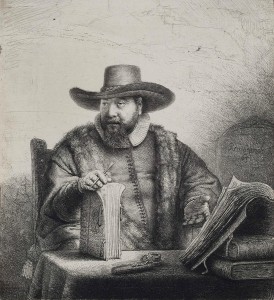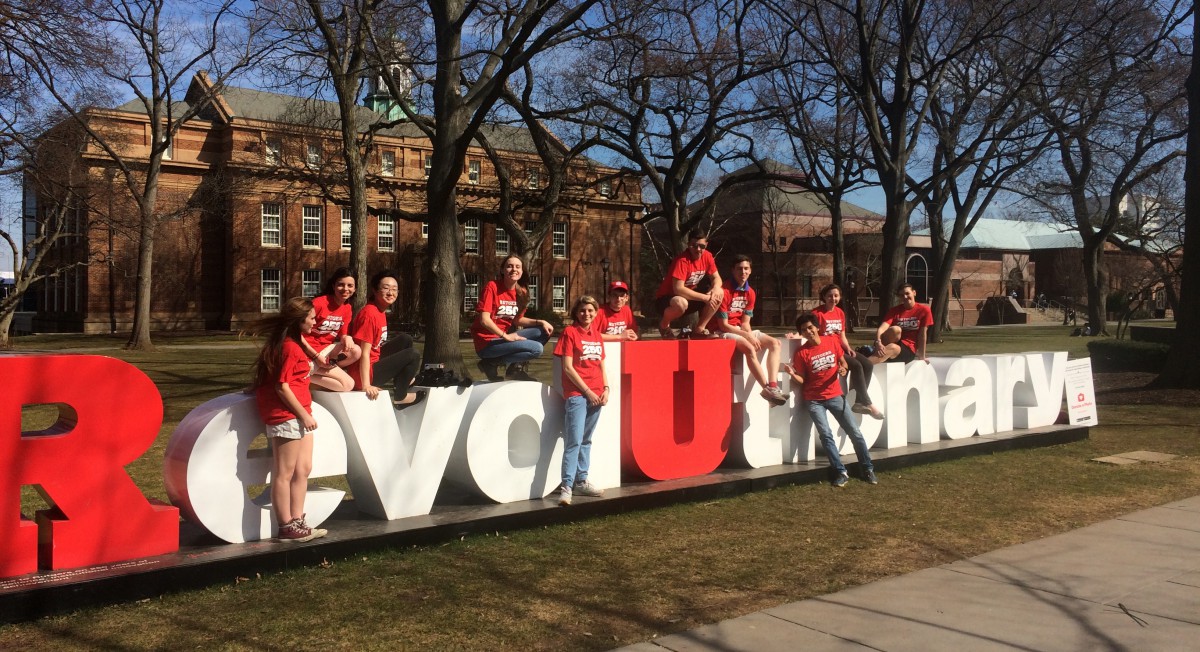Nishitha Kambhaladinne, Natasha Khatri, Ayesha Misra, Sushma Mannimala – Section 6

A Physical Description of the Painting:
This painting is called Portrait of Cornelis Claesz Anslo. He was a Dutch Mennonite preacher who was also a cloth merchant in the mid 1600s. The painting was initially made to only be admired by Anslo’s close family and friends. It was etched onto Japanese paper. Anslo lived in Amsterdam for his whole life, where Rembrandt painted this portrait of him. Rembrandt was known to draw and etch people of the Mennonite church quite often. Rembrandt depicted the merchant’s success through his rich attire. Rembrandt’s paintings are all a part of the Dutch Golden Age, because of how his work influenced Dutch history and culture.
Essay:
This painting, Portrait of Cornelis Claesz Anslo, is located in the Zimmerli Museum at Rutgers University. The painting was brought from the Netherlands to America at Rutgers University because of the relationship between the Dutch and Americans, and the influence of Dutch culture in America, specifically on Rutgers campus. The date of when the object was placed there is unknown. It was given to Rutgers University by the estate of Raymond V. Carpenter. This painting was created by Rembrandt van Rijn, a painter who is considered to be one of the greatest painters in Dutch History.
This is related to the Dutch because it was created by the Dutch artist Rembrandt. It signifies the importance of art in Dutch culture. In the lecture by Dean Jones, she goes through how art allowed the Dutch to develop their culture and capture it. Many of the paintings by Dutch artists are portraits because they believe in capturing reality. Many of the paintings discussed by Dean Jones follow this pattern of candid paintings. This influenced many American painters to adopt self portraits and made this a more popular theme in America. Many American-Dutch artists use these techniques today to maintain their culture.
This painting is connected to Rutgers because it was gifted to Rutgers to be placed in the Zimmerli Museum on campus. It adds to the enormous amount of Dutch history and culture in the Rutgers and New Brunswick area. Henry Rutgers himself was of Dutch descent so since the very beginning of Rutgers history, it was already being influenced by the Netherlands. Putting this painting on campus continues and expands on the never ending history.
We picked this object because it is located on campus in the Zimmerli Art Museum and is related to Dutch history. Some of us have seen this painting when we visited the museum. It is available for anyone to see and is free to the public. Today, people can look at this painting and realize how art was at the heart of Dutch culture. It shows that Dutch artists took time to replicate nature as best as they could and it was important for them to get their message across.
Rembrandt expresses the importance of capturing nature in each of his paintings. He believes that “ in paintings the greatest and most natural movement has [to be] expressed, which is also the main reason why they [take] so long to execute” (Rembrandt). He stresses the importance of working on the art to capture each detail and making it as close to nature as possible. The portrait was meant to capture the essence of Cornelis Claesz. He was a rich and powerful man who always had a stern expression. The point of the painting was to emulate his personality through the painting. Most of Rembrandt’s works were relevant to the city of Amsterdam and surrounding towns of Holland,“as both a flourishing artistic center and a cosmopolitan, polyglot community in which a variety of religious faiths were tolerated.” The man in the painting was a Mennonite preacher who believed in religious tolerance. This painting envelops the Dutch culture on campus and gives insight into the values of the Dutch.
Works Cited
“Cornelis Claesz Anslo.” Norton Simon Museum. Norton Simon Museum, 2016. Web. 06 Apr. 2016.
“The Mennonite Minister Cornelis Claesz.” Web Gallery of Art. Web Gallery of Art, Web. 06 Apr. 2016.
Rembrandt. Digital image. Zimmerli Art Museum. Rutgers University, Web. 6 Apr. 2016.
“Rembrandt Quotes.” Rembrandt. N.p., 03 Apr. 2004. Web. 06 Apr. 2016.
Fowler, David J. “Benevolent Patriot: Henry Rutgers, 1745-1830.” Rutgers University Libraries: Special Collections and University Archives:. Rutgers University, n.d. Web. 06 Apr. 2016.
Dickey, Stephanie S. “Contemporary Explorations in the Culture of the Low Countries.” Google Books. Metropolitan Museum of Art, n.d. Web. 06 Apr. 2016.
